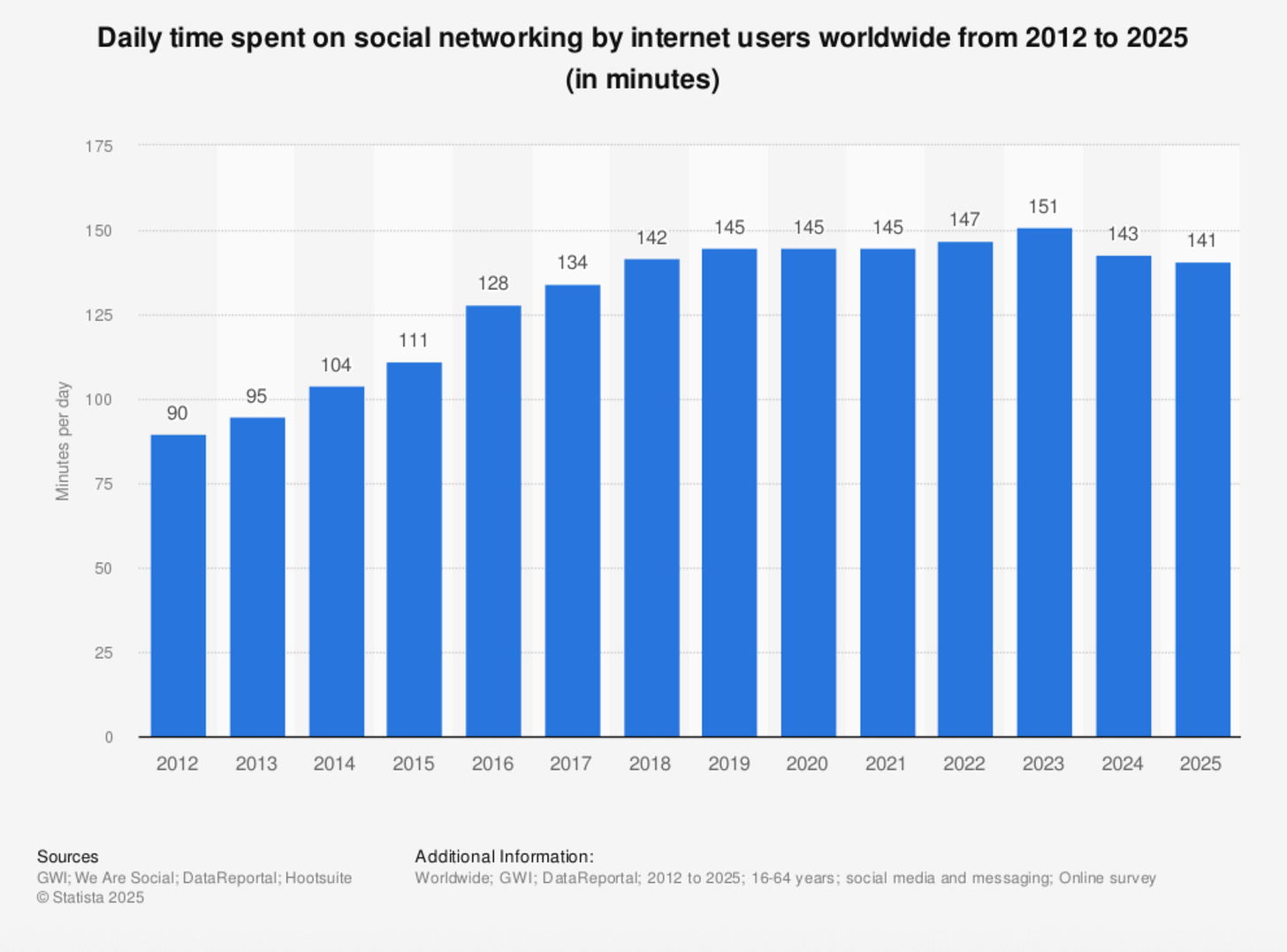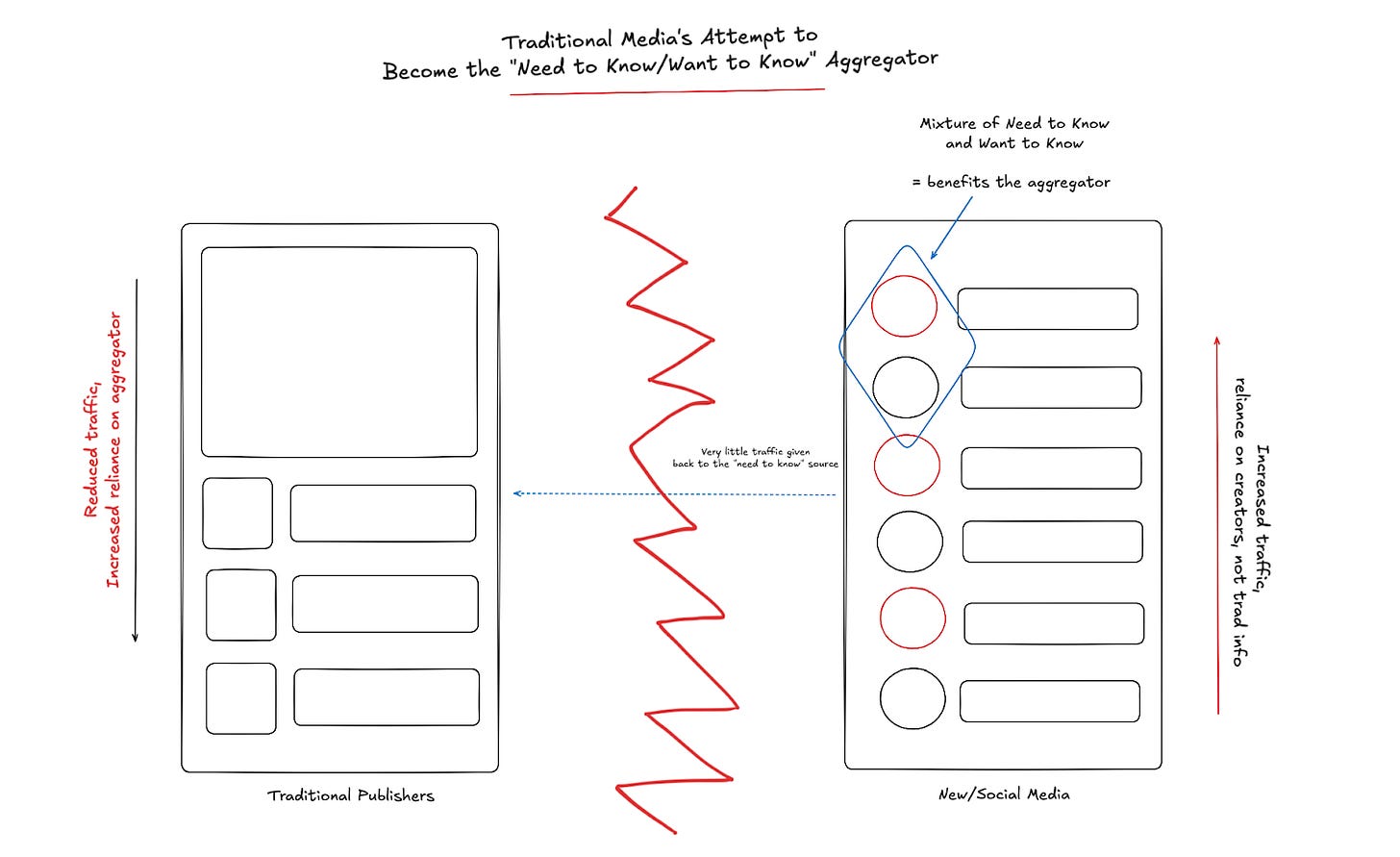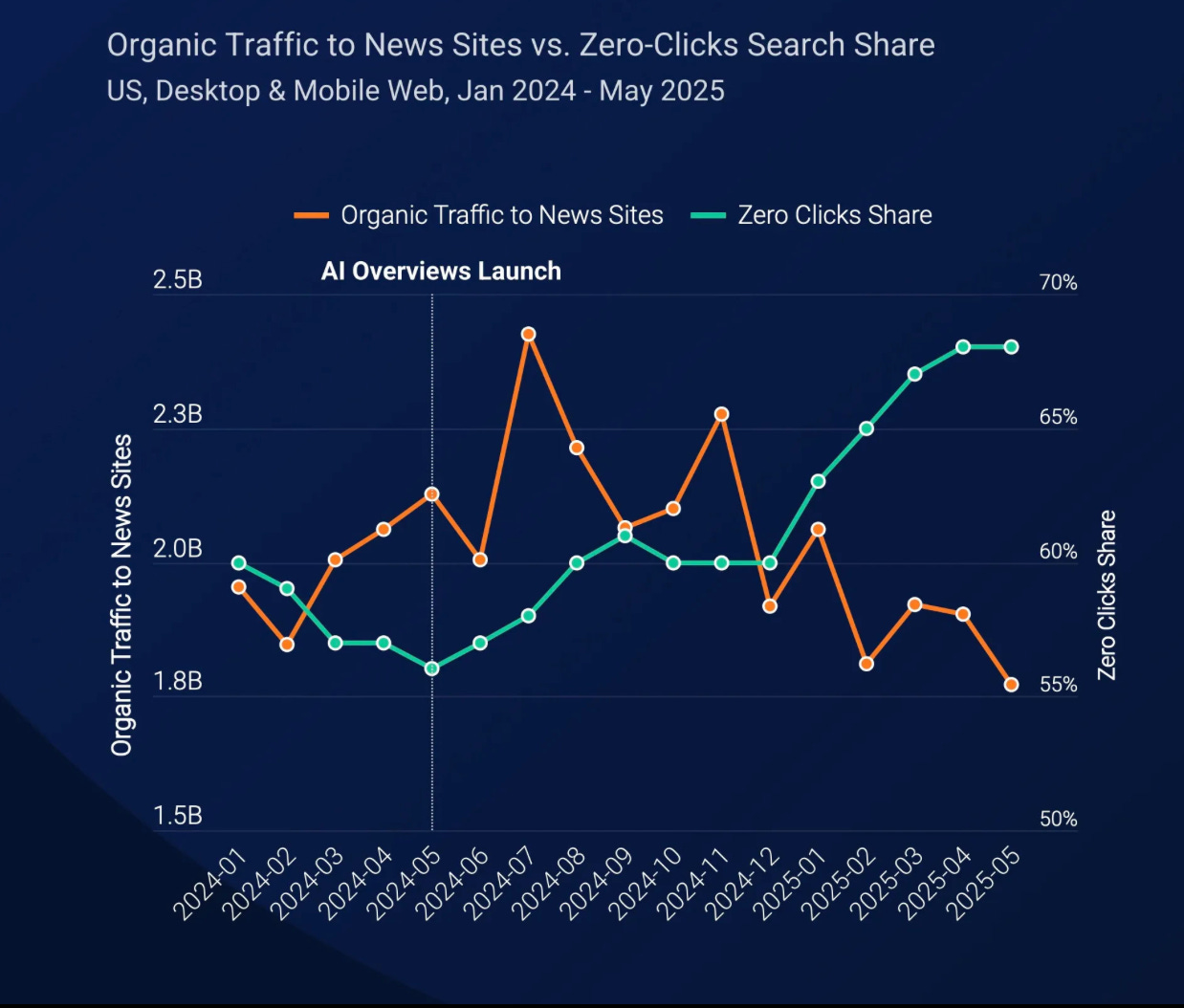How Digital Media is Fighting Back Against Its Demise
A look at interesting hypotheses from The Verge and Yahoo
Before social media algorithms completely rewired our brains, subconsciously training them to equate receiving information to a dopamine fix, information wasn’t intended to entertain. Information wasn’t a driver of euphoria; it was essential. Similar to oxygen, food, water, and shelter, without information we could not function as a global community.
We’ve conflated our desires and our needs. Information does not need to feel good. Information, however, must be good.
In Big Tech’s quest to change information from a building block to a pastime to deal with boredom, we’ve also conflated information with attention, and attention with value. Think about the most obvious examples. Twitter (now X) was created as a means for people to connect with one another. Jokes were traded, lunches were photographed, and news traveled. Facebook, but for anyone to connect with anyone rather than keep up to date with friends within our inner circles. Or, put another way, creating a network for anyone to get anyone and everyone’s attention with just the right post. The most important lesson that people took away from Twitter was the ability to trade any kind of information as we define it — something new, regardless of actual value — for immediate attention. It was a validation of self that didn’t require much effort and was perfectly manicured. A new joke, a new recipe, or actual news.
Smart and opportunistic executives at the biggest social media companies realized the more they could incentivize people to trade information (via rewarding participation with new attention), the more time people would spend on their apps. For companies like Twitter and Facebook, which introduced News Feed as a counter measure to the activity that was happening on Twitter, this translated to pure profits. After all, what are social networks if not fodder for much larger advertising distribution networks? People who became users, a term only employed by drug dealers and tech companies to talk about their customers, became full blown addicts. Partly to information, to the feeling of an endless scroll, but also to validation.
Feeding an addiction often means accepting a worse product over time. All that matters is getting a fix. And this demand for a fix translated to worse information traveling because of the worst incentives. Networks like Twitter and Instagram didn’t care about the quality of content, so long as people were posting. Their algorithms tweaked in the 2010s to promote engagement at all costs reflect this reality: conversation turned to vitriol, connection turned to dog piling; community turned to unfettered hate. It became a game of posting information for attention, not posting information to inform.
One of the most insidious side effects of this new reality was that publishers and new media organizations, the very people in charge of producing necessary information, felt compelled to align with the rules set down by addictive platforms. Publishers fed Twitter its content, journalists put more effort into followers than page views because the former led to job offers and the latter led to more work. Organizations struck deals with Facebook to create original video. All of these deals were made with the best intentions in mind, but the underlying hypothesis was that participating in network distribution centers like Facebook and Twitter would revert attention back to the publishers, and that’s ultimately where the overwhelming fallacy lay. Attention didn’t revert back, but those authoritative presences on social media made it easier for the average person to stop seeking out information sources in any form. This was the beginning of information finding people, rather than people seeking information. Twitter, Instagram, TikTok, and Facebook perfectly combined social (want to have information) and news (need to have information) into one endless feed.
Almost everything that’s bad in our digital world stems from this moment, but media companies and publications are finally starting to fight back against the inane stream of consciousness, the diatribe of our most pervasive id. How? By using those exact same technologies and tactics within a more controlled environment. It looks a little something like this:
A couple of media companies, including Vox Media and Yahoo, are toying with an interesting thesis. If we take the type of “want to know” information that people are seeking out whenever they reflexively open X, Threads, Bluesky, or Instagram, and blend it into the “need to know” information, can publishers take back some of the share lost to the social internet? Here’s how The Verge is doing it:
And here is how Yahoo is doing it:
A Must-Visit Island
Let’s start with The Verge. What I find most impressive about The Verge is how they’ve managed to maintain a loyal homepage audience. The homepage is still the most visited part of the site, with a strong portion of their readership visiting the site multiple times a day to see recent stories and find new videos or podcasts to watch.
Herein lies the first established rule of running a media business in 2025: you can buy attention, but you can’t buy loyalty. Only trust, built over time and through continuous relationships, builds loyalty. And loyalty can convert a readership used to free content into paying customers. Or, at least, a portion of those readers. Whenever I talk to Substack authors, I’m often told they expect about five to 10 percent of their overall subscriber base to convert to paying subscribers. That was certainly true when I ran Posting Nexus. At just over 1,000 subscribers, about two percent were paid subscribers. Though unfair to compare a Substack author to a major website like The Verge, the premise of customer conversion is the same. Enough trust in the information provided, and enough “subconscious attention” that trust builds (like looking forward to a newsletter, or reflexively going to a specific site), the more likely that reader is to pay for a product.
The Verge still brings in between 20 and 30 million visitors per month, making it one of the most viewed at Vox Media, with 50 percent of all engagement coming from direct traffic, according to SimilarWeb data for June. Roughly 36 percent of the site’s traffic comes from organic search, the research firm added. All that data tells us that The Verge’s audience is loyal, and even if they are not bringing in as many readers as they were prior to Google Zero (a term referring to the phenomenon of people searching via Google Search but not clicking on a link, which is now happening for 70 percent of all searches, per SimilarWeb), half their readership is still seeking out Verge content regardless of a specific story.
Here’s the difficult part. Social media sites didn’t just build their addiction driving behavior off of publishers and journalists providing information. There is a social component; a feeling of being connected to other humans around the world, sharing in the same interests and humor that we seek out in our own lives. If you publish “need to have” information that builds trust and creates habitual attentive habits, the next step is introducing “want to have” information. Social media trades mostly on having the latter. Memes, jokes, a one-off thought, and instant reactions are what drives the most participation. Companies like X and Instagram have built businesses bundling news with what amounts to a digital playground. Less than 10 percent of posters make up 90 percent of content on platforms like X, according to Pew Research. Unsurprisingly, journalists are a significant portion of those most active posters.
What sites like The Verge are attempting to figure out is if you encourage those providing content for free to X and Threads to simply post on an owned-and-operated site, can you regain a fraction of the attention that’s lost to bigger aggregators, creating new advertising opportunities in the process? It also highlights the authentic humanness of an editorial team, which builds more parasocial relationships between authors and readers, and may convert a larger percentage of free readers to paying customers. Their hypothesis, I imagine, looks a little something like:
Similar to pay TV, digital media is skirting down a very short runway very, very quickly. Even with all the advances we’ve made in our ability to make money off people’s attention, there are still really only two answers: advertising and subscription. Variations on these two models appear all the time — YouTube is a an-supported business but YouTube PrimeTime Channels and YouTube Premium lean into convenience and obsession with subscription add-ons — but everything boils down to eyeballs and adoration. The Verge’s new vertical feed, designed to be scrolled through even if further clicking doesn’t happen, is one example of that variant that dovetails between both options.
Built within The Verge’s quick posts feature are ads that mimic the design of the site itself. As I said to Verge EIC, Nilay Patel, I had forgotten that text-based ads could look good after how poor the advertising has gotten on X. This could become prime real estate for some of the more tech-focused and tech-adjacent brands who want to reach a highly engaged but specific crowd instead of hoping “reach” pays off in a much more packed space on X. This is because there is an intention behind readers visiting a site like The Verge that does not exist on social media. If a visitor is thoroughly engaging with every single piece of information that is served in front of them, even if they are not clicking on that information, then the response to an ad or its ability to resonate is much higher. I’ve included an example to the left.
Though The Verge’s move is unlikely to make up for lost profits that come from companies like Google sending a reduced percentage of monthly traffic, thereby eroding advertising revenue and decreasing discoverability for non-Verge readers, this will allow for stronger sponsorships and train a loyal audience to scroll even if they’re not necessarily seeking out a specific story. It’s the type of “want to have” content (quick, tweet-like posts) placed on top of the “need to have” (articles). After all, what is “want to have” content if not the type of information you weren’t planning to seek out, but the type that got you to stay? “Need to have” information is therefore akin to acquisition titles for a major streamer while “want to have” information would define the type of lean back TV that keeps members paying even after the initial binge is over.
What The Verge is trying to accomplish is Hotel California: keeping people engaged with The Verge’s own videos, articles, and podcasts for as long as possible. Taking the kind of dopamine-producing designs that have worked so well on social media platforms and translating them to an owned-and-operated platform where Vox Media executives can better control the advertising display, curation of information, and experience rather than giving information to a larger aggregator in hopes of traffic return and increased discovery.
And then there’s what Yahoo is trying to do.
An Empire of Aggregation
Aggregation theory, as made famous by Ben Thompson, also lends itself to my theory of empires and islands. The Verge is an island. Although technically it does aggregate some information, its function isn’t to act as an aggregator. Its readers come to the website to read stories from specific authors. Yahoo, however, is an aggregator. And Yahoo’s ambitions are to become the better option for island operators (publications like The Verge or Substack authors) to focus their efforts on for better discovery.
I know what you’re thinking. What fucking year is it? We’re talking about Yahoo?! I know. But over the last few years, Yahoo has made some fascinating investments and acquisitions focused on creating a more homogenous one-app experience that can make its app the starting point for someone’s day rather than social media. As I mentioned to my colleague, Dylan Byers, on an episode of The Grill Room, this isn’t going to make Yahoo replace X, Bluesky, or Instagram — but that’s not the intention. The intention is to reclaim some of that lost attention and focus it into longer sessions and muscle habit instead of quick clicks and even quicker exits.
We’ve explored what The Verge’s attempt to reclaim attention looks like if successful, but what does success look like for a major aggregator like Yahoo? It may seem crass to acknowledge Yahoo’s own marketing, but I believe the company’s new tagline gets to the heart of it: “a nice place to stay on the internet.” Right now, Yahoo reaches 90 percent of American internet users, according to Comscore, and half of those visitors belong to either millennial or Gen Z cohorts. Yahoo is also still one of the five most popular websites in the country. Some of its most prominent features, including finance, fantasy sports, and email have dedicated audiences who have used Yahoo’s tools for decades. Yahoo doesn’t have a problem getting people to its website, but how does it make Yahoo a place that people want to spend more time on, and how does Yahoo become a new centralized hub for the internet at a time when the very notion of how people access information is being upended by artificial intelligence, large language machines, platforms like ChatGPT, and agentic innovations?
We can glean some of these answers from some of the more major moves Yahoo has made in recent years, like acquiring Artifact, introducing a Creators feed, and building up core properties through smaller acquisitions like sports betting app Wagr..
The New York Times is often referred to as a lifestyle brand. It’s not a pejorative about the company’s journalism. The Times still produces some of the best reporting in the world, but news is far more difficult to commoditize. And as information is served faster to people through A.I. powered search tools, like ChatGPT and Clause, the reason to open an app or subscribe to a site like the Times becomes harder to sell. Naturally, this is why the Times is suing OpenAI (if information from the Times is going to power these engines, but the Times isn’t seeing traffic reflected and the business suffers, then the economic tradeoff is non-existent). Regardless of how that case plays out, the fee that OpenAI (and others) would be ordered to pay may not make up for dropped subs and lost advertising — especially for companies in more precarious positions than the Times.
Hence, games, cooking, weather, and shopping. The New York Times has become a place to go for want-to-have content that effectively bundles need-to-have information. Yahoo is trying to do the same thing but as an aggregator. Its core bets for bringing people into Yahoo are in fantasy sports, personal finance, and health — three areas that Yahoo thinks it can use technologies like Artifact’s strong machine learning recommendations to beat out other competitors like ESPN or CNBC. But once audiences are on Yahoo, the company’s role as an aggregator is to pair them with enough targeted information from trusted partners and sources that time spent increases.
Yahoo becomes even more of an attention empire, but its business is reliant on ensuring there is enough traffic flow to the various island operators in order for there to be leverage for those island operators, like Bloomberg or The Verge to want to partner with Yahoo. Data reminds us that Yahoo is the number one news publication in the U.S. when it comes to total traffic, but Yahoo’s news business is almost entirely reliant on its aggregation abilities. Yahoo works with several partners, paying them for access to their wire content. As Jim Lanzone, Yahoo’s C.E.O., said in May, “We got to [being number one] by being an aggregator. We’re aggregating thousands of sources and then using algorithms to surface the right ones for each of our millions of users.” Media partners get affiliate revenue, and Yahoo can drive additional advertising revenue on increased eyeballs.
In order for Yahoo to continue building out its monthly audience visit rate and increase the amount of time that people are spending on a website, Yahoo needs to create incentives for its publisher partners to continue working with Yahoo. But it also needs to double down on the kind of want-to-have information and ancillary services that separate it from the rest of the strict information plays from other aggregators, like Google and Apple
Almost everything comes down to a game of incentives. Why should I do this, and why should I stop doing this? If you’re a publisher, incentives come in the form of traffic and revenue. The first used to make up the second; now licensing deals are trying to replace what traffic drop offs have lost. As Lanzone notes in an interview with Fast Company, Yahoo is a significant part of the traffic delivery ecosystem. Even if Google is king (and no one would be stupid enough to deny that today), Google has showcased that its priorities are elsewhere. That makes focusing on Google’s indexing system by leaning into search engine optimization hacks less of an incentive for publishers than it was a decade ago. “It’s very important to us to keep the ecosystem very healthy, at least how it historically was,” Lanzone told Fast Company. If Lanzone can get the incentive right, Yahoo starts to look a little like the below diagram.
Leverage used to exist on the right side of the above figure. When revenue was more heavily tied to figuring out these social platforms (referral from X, direct revenue from Facebook a la pivot to video), there was more incentive to play by the rules laid down by the Jack Dorseys and Mark Zuckebergs of the world. Now, however, when social media platforms are sending out less content, and when even Google is approaching Google Zero faster and faster each month, the leverage and incentive sits with groups on the left of the diagram. Publishers can’t completely ignore Google because it’s still one of the best sources of traffic even if it is diminished traffic. Lanzone recently told Fortune that “sending [publishers] traffic, sharing the revenue, we still have that business today,” adding that “we accentuate that with our own journalists who are providing context to those stories, [but] our role is to be the trusted guide, and to help our users get to the content that they’re looking for.” As Lanzone put it, Yahoo has “a huge amount of traffic, and we send a huge amount of traffic,” but key to that traffic play is ensuring that Yahoo is “a trusted source and that means having trusted partners.”
A New Potential
But simply having the most information isn’t enough. Monetizing publishing and information on the internet is already starting to change. I like the way that Cloudflare’s C.E.O., Matthew Prince, hypothesized about it. Prince was talking about Cloudflare’s new crawling blocking tool, which gives publishers and website operators the ability to opt-out of having A.I. scrape from their website. So far, one million clients have opted-out of crawling. This affects companies like OpenAI’s ChatGPT but doesn’t necessarily impact Google AI Overview because of technical reasons I won’t try to explain. (You can read about it here.) As Prince noted, in a new A.I. search ruled environment, it’s not the scale of information that’s important, but the quality and application of that information to the needs of a search portal powered by an LLM. Here’s Prince:
“Next, we’ll work on a marketplace where content creators and AI companies, large and small, can come together. Traffic was always a poor proxy for value. We think we can do better. Let me explain. Imagine an AI engine like a block of swiss cheese. New, original content that fills one of the holes in the AI engine’s block of cheese is more valuable than repetitive, low-value content that unfortunately dominates much of the web today. We believe that if we can begin to score and value content not on how much traffic it generates, but on how much it furthers knowledge — measured by how much it fills the current holes in AI engines “swiss cheese” — we not only will help AI engines get better faster, but also potentially facilitate a new golden age of high-value content creation. We don’t know all the answers yet, but we’re working with some of the leading economists and computer scientists to figure them out.”
If these moves work — and it’s a big if — there are a few interesting possibilities for aggregators like Yahoo. First, an acknowledgment. None of this will directly impact Google; websites are too reliant on Google’s traffic, and the entire internet as we know it is basically indexed to Google. Trying to disrupt that now isn’t going to work. But Google also represents the current internet and, therefore, potentially the internet of the past. It’s the large language models that are trying to find their way into content without paying for it, as traffic is plummeting alongside revenue, where attention is focused. If this works, companies like OpenAI and Perplexity will be fine, but publishers still need to figure out how to increase their overall traffic (on top of revenue sharing opportunities) without investing heavily into talent, production, or technology that may not pay off either in the short run or long term.
Aggregators, therefore, where people are visiting more often for non-news related wants (like fantasy sports and personal finance), and increase discovery for publishers who may be blocking their information from appearing in ChatGPT (until a better monetization model is created), and are still dealing with Google Zero’s fallout, become even more important. If Yahoo is smart about it, and OpenAI execs are more laissez-fare than they should be, it could look a little something like this:
This would give aggregators and publications even more potential incentive to focus o honing their own products, and building audience loyalty that can translate into more direct revenue from initiatives like Prince’s and licensing deals from Yahoo.
My Hope
Here’s the thing: for all that I don’t know what A.I. will do for how we consume information — there is so much I won’t pretend to even guess — I can say with some confidence that for the time being, the way that we interact with information will look similar to today. It’s all browsers and apps. Even the biggest AI companies seem to be betting on that immediate future, despite forging multi-billion dollar partnerships with innovative geniuses like Jony Ive in hopes of radically redesigning our computational future. Therefore, the biggest change for how people get information and how information is commoditized is threefold: scale of information available, speed of how that information is served, and where advertising is placed.
In all three of these cases, artificial intelligence companies like OpenAI and Perplexity, alongside Google, win. Information will scale tenfold thanks to “zero code vibe operators” who see pure opportunity to create websites that aggregate information from wherever possible, until the amount of aggregated information and the attention paid to that information outnumbers anything credible news outlets and experts. What we lose in trying to capture as much time as possible is the ability to take time and question things. Producing good information takes time to reflect on a question, to poke holes in a theory, and to build expertise around a subject.
Our new truth is as simple as it is distressing: we used to seek out information to help deepen our thinking, and now we expect information to find and think for us. It’s not laziness, it’s the intended effect of designs built, tinkered, and experimented with by people in rooms across Silicon Valley. But the good thing about this reality is that people will push back on it to make a better one for themselves.
Curation and trustworthiness become more important. Time spent goes from dopamine hits to valuing engagement. Learning once again becomes an act of humanity, not just something that may happen based on an algorithmic decision. And it’s here that The Verges and Yahoos of the world may be able to claw back some of that attention, turn it into engagement, build loyalty, and secure more prominent advertising and brand deals without being reliant on Google’s demand-side technology.
None of this will make up for the immense losses that every digital publisher is going through. But it doesn’t have to mean the end of middle-class journalism.
There are new ways to monetize, there are new audiences to engage, and there are loyal audiences to lean on for support. Businesses like The Verge will look smaller, and Yahoo may become just a little more prominent. Employees will likely be laid off. But these websites and businesses may survive.










Great piece Julia! Love what The Verge is doing. And I miss Artifact.
Press Gazette had an interesting piece out today about how Google's Discover feed has become a meaningful part of the traffic mix for publishers.
"Meanwhile, Google keeps all the advertising revenue from Discover (in contrast to other aggregators, like Samsung News, which give publishers a share of advertising)."
I bet publishers wouldn't mind a cut of the estimated $500 million USD - $2 billion USD of ad revenue that Google's Discover feed generates each year:
"Alphabet’s financial reporting doesn’t break out Discover revenue – it is bundled within its “search + other” line – but a back-of-the-envelope calculation based on the user figures we do have (800 million monthly active users in 2019) and making some assumptions about the MAU:DAU ratio, scroll behaviour and ad load suggests it’s probably generating between $0.5bn and $2bn."
Which makes me think Artifact could have been a big business if the Instagram guys stuck at it. Apart from Apple News+ (which is only available on Apple platforms) there's just not a compelling place to get 100% aggregated news links cross platform. Also the benefits of Artifact to Yahoo! seem to be pretty much US only which is crap for non-US users.
https://pressgazette.co.uk/comment-analysis/google-discover-traffic-news-websites-2025/
As always, cogent analysis from Julia here. But I fear the implications of this key passage: "People who became users, a term only employed by drug dealers and tech companies to talk about their customers," Drug addicts still take drugs, long after their lives have been destroyed. The users of enshittified social media platforms still use them, while regretting they were ever created. As a disaffected LinkedIn user, I was shocked to see that the enshittified LinkedIn has actually seen user activity grow. My hope is for human attention receptors to be continuously saturated to the point of exhaustion, but that day may be a long, long way away.